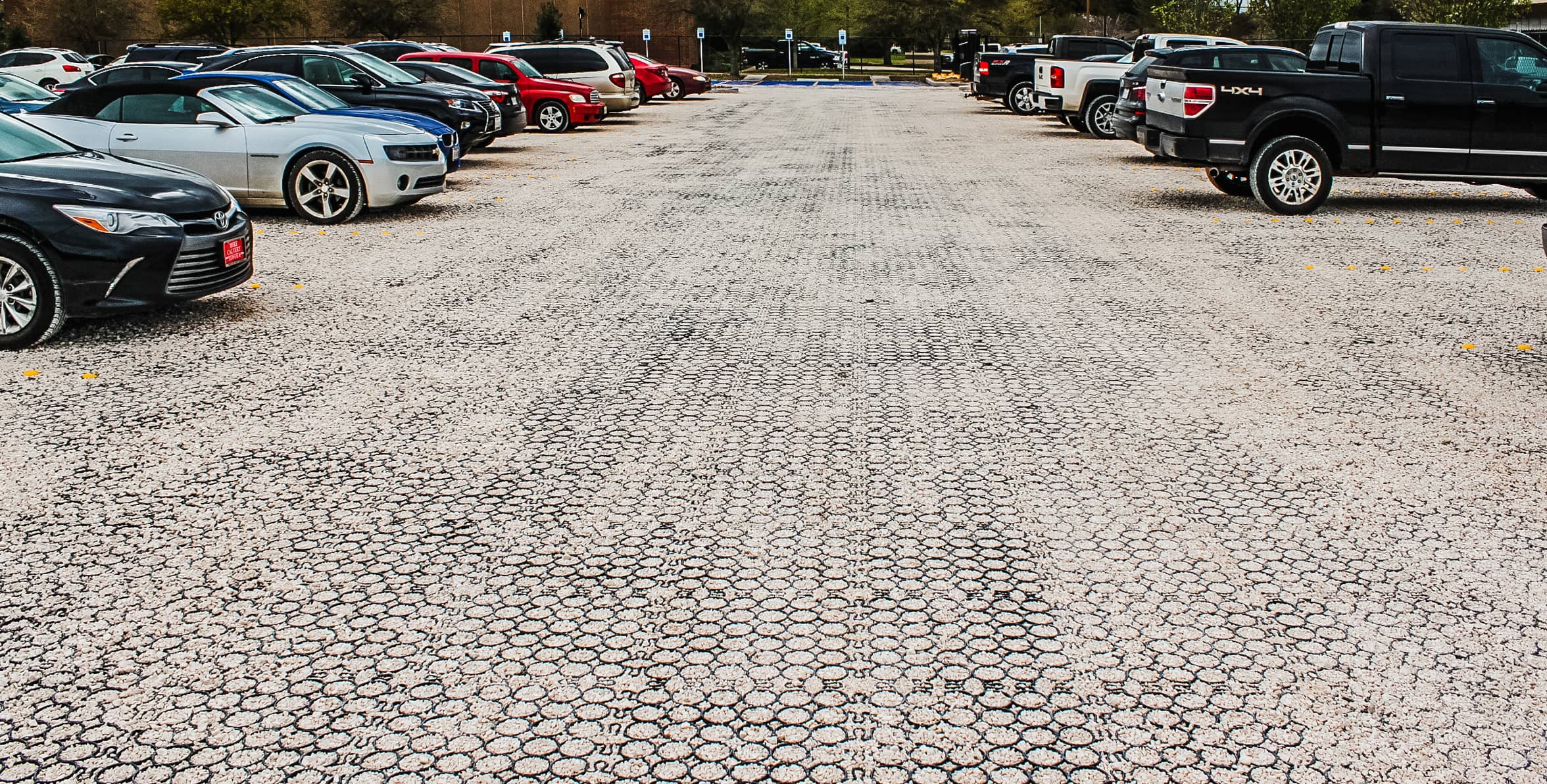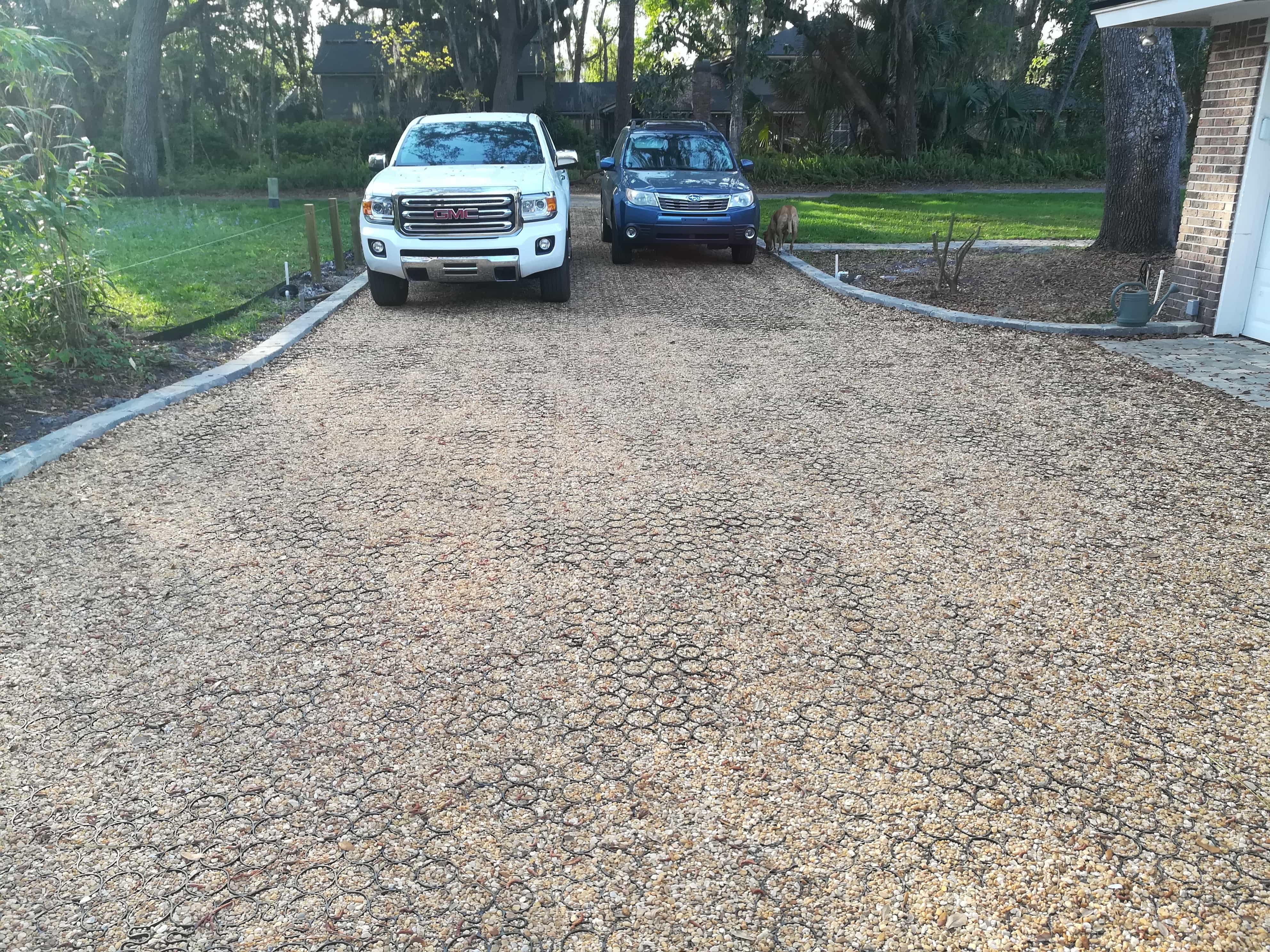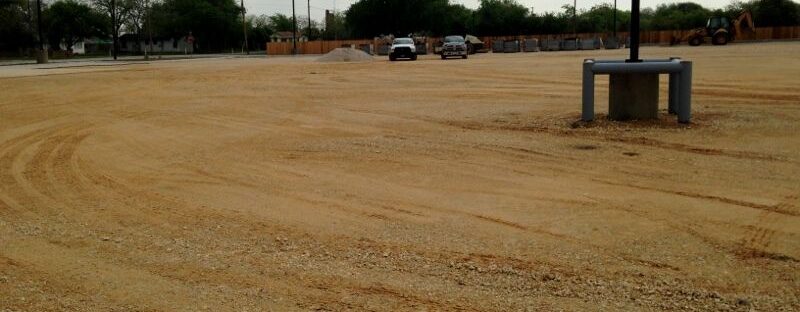
Gravel patios offer drainage, durability, and a clean finish—but only if the right material is used. The best gravel for patio use combines comfort underfoot, reliable drainage, and long-term surface stability. Performance depends on the gravel’s shape, size, and how it behaves under traffic and weather.
Crushed Stone (½”–⅝″ Angular Fill)
Crushed stone offers the best stability for patios. Its angular edges interlock under compaction, keeping the surface firm without sealing off drainage. Sizes between ½” and ⅝ inch provide enough particle variation to prevent migration while allowing water to flow. This type also supports heavy furniture or foot traffic without rutting. This makes it one of the best gravels for patio applications where both drainage and surface lock-in are especially important.
Decomposed Granite (DG) for Compacted Surfaces
DG forms a semi-solid surface when compacted, which makes it good for patios where a firmer feel is needed. It drains reasonably well and locks down tightly. However, it may turn dusty in dry weather or sticky in rain, especially without a binder. It’s best used where runoff control is a bigger priority than comfort. [editors note: pea gravel is not the best fill for inside grid pavers]
Pea Gravel for Comfort-First Patios
Pea gravel is rounded, smooth, and often chosen for visual appeal. It feels soft underfoot but doesn’t lock in place. Without edging and compaction, it shifts frequently. This movement creates uneven areas and increases maintenance. For patios that get daily use, pea gravel must be installed over a stable base and confined properly. [editors note: pea gravel is not the best fill for inside grid pavers]
Decorative Stones with Lower Performance
Materials like marble chips and lava rock are sometimes used in patio settings for appearance, but they fall short in performance. Marble chips tend to crack under pressure and reflect heat, which can make walking surfaces uncomfortable. Lava rock is lightweight and porous, making it prone to scatter or erosion without full containment. These options may work in low-use garden paths, but they lack the strength and structure needed for everyday patio traffic. [editors note: pea gravel is not the best fill for inside grid pavers]
Summary: Which Gravel Performs Best?
Crushed stone offers the best mix of drainage, stability, and compaction, making it ideal for patios that see heavy use. These can also be the best for infill on grid pavers.
Decomposed granite works in dry zones with firm, binder-treated surfaces, but it struggles in wet climates without proper stabilization.
Pea gravel feels soft underfoot but shifts easily, so it’s best for small, comfort-first patios with strong edge control.
Marble chips and lava rock are best reserved for decorative borders or low-use areas due to poor compaction and scattering risk.
What to Consider When Choosing Gravel
The ideal gravel performs in real-world conditions—not just in photos or showrooms. Material size, shape, drainage behavior, and comfort all affect how well a patio holds up.
Particle Size and Shape
Gravel in the 1/2 to ⅝ inch range typically performs best on patios. Angular particles interlock more tightly than rounded ones. Avoid overly fine gravel, which compacts into a near-solid layer and reduces drainage. Overly large stones can create a wobbly, unsafe surface.
Surface Drainage and Infiltration
The best gravel for patio drainage allows water to filter through evenly without pooling. Clean, angular material without excess fines encourages fast infiltration into the layers below. A properly layered system should shed water through every layer—from surface gravel to the underlying soil.
Comfort, Stability, and Refill Cycles
Round stones shift more and feel loose underfoot. Angular gravel stays in place but can feel harder to walk on. The best gravel for patio use strikes a balance between firmness and comfort. Loose gravel often forms low spots and needs periodic top-up, especially in high-use areas like seating zones or walkways.This makes TRUEGRID a top choice for builders
Proper Installation to Prevent Surface Failure
Even the right gravel will fail without the correct base and edge controls. The installation sequence below prevents sinking, washout, and erosion.
Base Preparation and Compaction
Start by excavating 4–8 inches depending on soil and climate. Softer soils like clay or loam require a deeper base—closer to 8 inches—to prevent settling. Sandy or well-draining soils may only need 4 to 6 inches. Add 4–6 inches of compacted road base or ¾” to 1.5” drain rock. This base layer should be made from crushed stone with fines to create a solid, load-bearing foundation or a good drain rock – sharp, hard/angular, uniform size.
- Use a vibratory plate compactor to consolidate each 2 to 4 (maximum) inch lift.
- For proper density, with road base,, aim for at least 95% modified Proctor density or 8–10 passes with a plate compactor.
- On larger installations or areas with vehicle access, grid systems like TRUEGRID PRO PLUS can be used to meet H-20 load ratings, distributing weight evenly and reducing the compaction stress on underlying soil.
When layered correctly, this system supports infiltration rates of up to 800 to more than 1000 inches of rainfall per hour per square foot, depending on the fill and subgrade. That capacity eliminates runoff in most residential settings and keeps the patio surface dry and functional year-round.
Example Layer Stack:
Nonwoven geotextile (on the floor and up the sides)→ 6″ compacted drain rock (1” uniform size) → TRUEGRID PRO PLUS panel → 2″ angular stone infill (¾” uniform size)
Fabric Barrier and Edging
A nonwoven geotextile layer between the excavated area and the stone base prevents material migration and maintains separation between adjacent soils and base layers, which protects the patio structure from settling..
- This permeable fabric allows water to pass through freely while blocking weeds and fine debris.
- It also stops the gravel from working its way down into the sub-base, which can cause settling and surface failure.
- The geotextile fabric acts as a separation layer that protects the structure of the patio from internal erosion.
- Optional: Along the edges, rigid restraints—such as steel, composite, or concrete—hold the gravel in place and stop it from spreading outward under foot traffic or rainfall. Note, the geotextile fabric, placed up the sides of the excavation, all the way to grade will also accomplish this.
How Gravel Grid Systems Lock in Surface Stability

Some patios need more than layering and edging. Gravel grid systems lock stone in place and reduce surface wear.
Structural Behavior Under Load
Gravel grid panels distribute pressure evenly across the base. They prevent displacement from foot traffic, carts, or furniture legs, and for retail or commercial applications, they can support food trucks, delivery trucks, and more. This keeps the surface smooth and minimizes rutting—especially in patios that see daily or heavy use.
Drainage and Surface Longevity
Gravel grids also improve infiltration. Water moves through the gravel, into the grid cells, and down to the base without pooling. This prevents erosion and helps patios dry quickly after rain. It also extends the life of the surface between maintenance cycles.
TRUEGRID System Integration
TRUEGRID’s permeable panel systems form a stabilized gravel surface that resists rutting and handles traffic without shifting.
- For residential patios, TRUEGRID PRO LITE provides a lightweight, easy-to-install panel that keeps gravel firmly in place and reduces maintenance. With a proper base layer, these grids can also support residential cars, trucks, and RVs.
- For patios that may see heavier loads—food trucks, delivery access. or utility access—TRUEGRID PRO PLUS adds extra panel strength with built-in flex joints and H-20 load capability.
Both systems are filled with angular stone and require no sealing, curing, or chemical treatment. Once installed, they create a clean, permeable surface that stays level, sheds water quickly, and performs season after season. TRUEGRID gives builders a proven way to create the best gravel for patio systems—stable, durable, and code-aligned.

Code-Friendly Stormwater Compliance
Stabilized gravel patios using permeable grid systems are often recognized as pervious surfaces under local drainage codes. This can help homeowners stay within impervious coverage limits, reduce runoff obligations, and avoid the need for separate stormwater infrastructure.
Maintenance Tips to Extend Patio Life
A gravel patio is only as good as its upkeep. Maintenance schedules and proactive checks can keep it working for years.
Rake and Refill Intervals
High-use areas may need light raking monthly and gravel top-up every 2–3 years. Migration is reduced with proper edging and grid systems, but some refill is normal.
Note: patios using gravel grids will require very little maintenance. Refilling of gravel, raking, or brooming are typically never necessary.
Preventing Weeds and Surface Wear
Weeds thrive in organic debris between gravel layers. Keep the surface clean and replace any clogged sections of fabric if water stops draining. Compact any soft spots that appear over time to prevent low points or puddles.
Note: TRUEGRID patios will typically reduce any need for compaction, low spots, or puddles.
Choose TRUEGRID for a Stable, Low-Maintenance Patio
Design a gravel patio that resists rutting and eliminates surface shift. TRUEGRID’s permeable panel systems lock gravel in place, reduce upkeep, and support traffic without cracking. Contact us today for more information.



